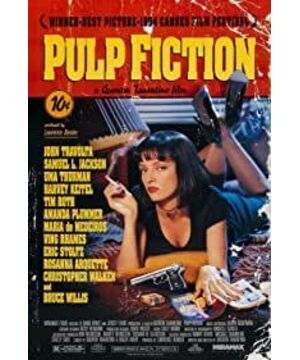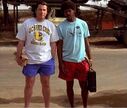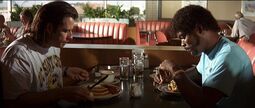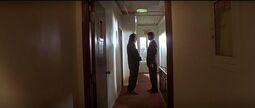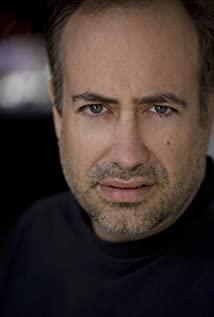Memento in 2007 can be said to be an intellectual game for movie viewers. It requires a high degree of concentration to get rid of the maze of memory with the protagonist of the movie. When fragments of fragmented memory passages intertwine and rise in the two narrative clues of pros and cons, the subversive logic of time and space has won an unprecedented victory. The audience was enthusiastic, the film reviews were like a tide, the tense atmosphere and the suspenseful momentum was like a rainbow.
But when these audiences who are already familiar with the audiovisual experience of space-time subversion, look back at Quentin Tarantino's "Pulp Fiction" in 1994, I believe there will still be surprises.
The film named "vulgar" and "novel" at the beginning of the film seriously quoted the definition of "American Heritage Dictionary" (American Heritage Dictionary), giving the definition of "pulp" (vulgar): 1. A kind of softness , Damp, indeterminate matter, 2. Magazines or novels with sensational content, generally use crude paper.
The director is a good student, must quote an authoritative dictionary? Afraid that the audience does not know the definition of "vulgar"? Or, is Quentin suggesting that his films, like the "Penguin" version of popular literature that was born in Britain in 1935, are recycled paper and story fragments made by mixing up various discarded newspapers and books?
This picture of white characters on a black background opened the curtain of a feast of collage, or personally called "audiovisual hyperlinks".
The whole movie has been divided into several paragraphs with paragraph titles:
1. When a pair of lovers "Little Pumpkin" and "Little White Rabbit" were eating in a restaurant, they suddenly wanted to rob the restaurant. As soon as they took it out, they put on the credits.
2. The killer Vincent and Jules chat all the way, go to kill people and get back their suitcases. When it comes to Vincent, he wants to accompany Mia. At the end, the two shot Brett at the same time.
3. "Vincent and Marsellus' Wife": Vincent was ordered to accompany Mia for one night, the two danced, and then Mia took a drug overdose. At the beginning of this episode, Butch and Vincent wore T-shirts and had an unfriendly face-to-face with the gang boss Marsellus. Finally, it is the passage when Butch got the legendary gold watch when he was a child.
4. "Golden Watch": Boxer Butch cheated the boss's money and ran away, but in the process of getting the gold watch back, he rescued the humiliated boss. In this episode, Vincent and Mia met again, when the boss found out that Butch lied to him. Also in this paragraph, Vincent was shot and killed by Butch.
5. "Bonnie's situation": Going back to paragraph 2, after shooting and killing someone, another person ran out of the toilet. After Vincent's gun misfired and exploded the informant's head, Vincent and Jules went to the old partner's house to ask for help. Put on a T-shirt here.
6. Vincent and Jules wore T-shirts and came to a restaurant for breakfast, so they encountered the first robbery.
According to the clues hidden in each paragraph, or "Ming Zang", the correct sequence of story development can be clearly arranged as 2-5-6-1-3-4. In general, the logic does not come to a complete subversion like "Shards of Memory", but only after the seemingly coherent 2, 3, and 4, the timeline is reversed abruptly and cut back to the beginning of the murder. But there is a strong sense of rupture between these fragments, just like the surprise of a new context after clicking on the link of a certain keyword. Take the gold watch, for example, after watching the nervous and complete clip of Mia being rescued, a child appears watching a cartoon, and a soldier magically tells the story of a gold watch. Even save the advertising time in the middle of a TV series, and relax for a moment. And the protagonist of the ad was still a mysterious character "Butch" that appeared on TV just now. The audience was naturally attracted by this "ad" and wanted to know more stories related to it, so the underlined "gold watch" appeared on the screen. Character. This is a jumpy sense of complete hyperlinks.
The jumping sense of the hyperlinked narrative is also reflected in the lines. Language has brought out an ever-increasing amount of information, and new time and space have been introduced. For example, on the first paragraph before the murder, two big men in black went from burgers and cheese, and even while killing, they talked about Mia. Gossip, talk about burgers.
But sometimes you will find that you can't avoid certain advertisements, and the gossip of certain celebrities will be mentioned wherever they go. If you jump, you can still touch the "avenue" that the world follows. Very attentive and detective viewers may find that on the way back home from Butch in paragraph 4, there is a signature JACKRABBIT SLIM'S in the background. This is the place where Mia and Vincent ate in the third paragraph. The world is small-a wonderful story. It may happen in the restaurant on the corner of your house. The world is huge-so many people have independent personalities and profiles.
The random combination of links also brings another feature, that is, the so-called "multi-angle" and the determination to re-examine the world order. There is a "three-point interview" method in news theory, that is, the ins and outs of an event must be explained by three parties with different interests, so that the world in the eyes of all parties presents mutual tension, and they appear in a report juxtaposed. In "Pulp Fiction", Vincent has a pigtail, is covered in fat, and mumbles. In the third paragraph, he acts as the protector of Mia, dancing, saving people, and the absolute protagonist. But in the fourth paragraph immediately after, Vincent is a "runner" who was shot and killed as soon as he came out of the toilet. If only the development of the story clues, who would know that he can dance and has a cute and emotional side. Coupled with the passages where he and Jules killed people together, his side as a killer is impulsive and impatient. All kinds of images are gathered in one body, forming a strong tension, causing the audience to think. When I watched it for the first time, I couldn't even believe that this Vincent was really easily killed by a single shot. The director does not worry that the audience will not accept it, and does not arrange some delicate emotional transitions at all, and develops the plot by himself. In addition, the gang boss Marsellus was sitting in danger, being raped, being hit by a car, and many other angles. The differences in the chanting of the scriptures at the front and rear ends of Jules are equally strong.
It is not difficult for the current audience to clearly see the main line of the story and the narrative sequence of the story. The difficulty is to use the relaxed mentality of the game like a director to dissolve and deconstruct everything, carefully and randomly intercept and reassemble the pieces. Some people use "scatter shooting technique" and "circular narrative structure" to describe this illogical logical view which is different from the traditional "linear space-time concept", but I prefer to use the term "hyperlink" because of the "post-industrial era" "It has become a past tense that stops at a text carnival, and the digital experience and audio-visual experience brought about by the existence of the Internet have swept you and me in an unprecedented situation.
In the so-called post-industrial era, the so-called web2.0, or the information implosion of the post-modern media society, all kinds of "cultural studies" (Cultural Studies) refer to a new context, a context that a film needs to talk to . People are getting used to the Internet. Microsoft's Windows system is outdated and replaced by Google's "cloud plan"-in the troposphere for thousands of kilometers, people can already go from a photo to a blog, from Adsense ads. Go to the MIT online class. Some people say that this is an evolution of thinking to leap and flow, but there are also criticisms that freedom makes people lost in the link itself, lost in the existence of the vast ocean of information rather than in life. "The overall narrative of modernist films has lost the conditions for existence. Postmodern film directors have abandoned the causal-led meticulous and rational narrative and pursued fragmented images." Anyway, it is time to change.
Lywood’s classic narrative line arrangement is logical, with ups and downs. Adopt the method of Shunxu and flashback.
Flashback is also a more classic narrative structure, classic films such as "Titanic". From the salvage of the shipwreck and the elderly rose, re-seeing the "Heart of the Sea" as an opportunity to awaken a poignant century of love. The court musician of "Mozart", his reminiscences and emotional advancement cut the memories of Mozart into many fragments, but because of his emotional clues, the whole story of Mozart is still complete.
Or like "Red Violin", interspersed with past and present lives, the ups and downs of this violin a hundred years ago under the long-term experience, and dozens of minutes of bidding on the contemporary auction site, the whole process is interspersed with more suspense and suspense. Proximity.
The narrative structure of "Pulp Fiction" can be compared with that of a film, "sin city". Composed of three short stories, violent and bloody stories developed in Sin City, but the protagonist of each story is a different person, and the connection between each other may be in the same background-one signed a contract with the police Leave it alone, a "city" supervised by women where you can freely traffic in drugs. The more interesting connection is that Jane, the little girl protected by the giant who appeared in the first segment, turned out to be the protagonist of the third segment. Her dance is impressive. When the giant appears again in the bar, the audience will get a A strong look and feel different from previous movies. But the stylization of the overall shooting in sin is very strong, and the themes and clues between the stories are relatively independent. It weakens the postmodern deconstruction meaning of "Sin City".
Quentin Tarantino's work is hailed as a classic of postmodern cinema. This director and screenwriter who had worked in a movie rental shop also participated in the scriptwriting of another film "Run Lola Run" that broke the traditional narrative structure. For post-modern times, production is used to be destroyed. The narrative line is played with the spirit of game and criticism, which brings a crazy movie-watching experience, and wins the attention of the audience with a strong anti-traditional spirit and "novelty" skills. .
Such a deconstruction with a rebellious spirit is exactly in line with the postmodernism, collage, and pop culture that prevailed in the art world or the ideological world at that time. Andy Whahol's "Marilyn Monroe", Richard Hamilton's "What makes today's family so different and so charming" (1956) are all products of this new order created by collage and fracture. Walter Benjamin said that the role of the TV box in changing the direct and undisciplined relationship between the image and the world is inestimable.
The director and screenwriter of "Pulp Fiction", Quentin Tarendino even more frankly confessed his postmodern tendency, thinking that everything can be ridiculed. He once opened a video rental store, where he not only enjoyed all kinds of movies, but also cultivated his jumping thinking to shuttle through various story scenes. In some of the clips in this film, he also uses classic bridges from other films.
Although subverted, another manifestation of postmodernism-the salvation of religion seems to be inevitable in this film. When the postmodern era denied all values, the director talked about this theme in a few short clips, expressing his public sentiment under cynical cynicism.
The film is full of words starting with F, and all-encompassing violence such as shooting, gangsters, bribery, drug abuse, police crimes, etc., but these "vulgarities" often make the audience laugh, such as when the glands are pierced by a needle. After Mia's heart, the phrase she said "something", or the scene where Vincent and Jules were washed in cold water and changed into Tshirts.
Some people say that Quentin's greatest contribution is to make the "shallow" post-modern film into an "epic". He made us feel relaxed and violent, and also experienced the early arrival of a new era, and now this era is all around us, just look at the numerous scenes on Youtube and the hundreds of millions of links on Google, and the answer will be known.
View more about Pulp Fiction reviews


